With joy, colors and a lot of dancing, the programming of the Southern Carnival began, which, at its opening, united national folklore and Andean dances within the framework of the central concept of this version, which is “heritage”, thus giving transition to a series of activities that extend until December 2, with the traditional theatrical intervention in the natural settings of Cerro Phillipi.
Carolina Cruz, general director of the “Carnaval del Sur” experience, indicated that the objective of this opening focused on heritage is “on the one hand, to refresh this concept considering we are closely linked to architecture and on the other, to generate collaborative instances.” between brothers of carnival and that in addition to transmitting the knowledge and culture of other peoples, the artistic that is dance is also shared, with the folklorists, boys, girls and the audiences of Carnaval del Sur, so that people can observe and understand the cultural differences we have.”
Regarding this new version, the cultural manager also explained that the programming includes several components such as lambe lambe theater, storytelling, mosaic inauguration and the now traditional closing in Philliphi Park, which “has a space for contemplation, for coexistence in citizenship , of respect, of observing”, which, following the etymology of what a carnival means, “worships Mother Nature and I would say that it is the meeting point that we have with the other carnivals in Chile, which is ultimately about to celebrate something bigger than us, than humanity, such as the sun, nature and in our case, fauna,” Cruz highlighted.
For his part, the coordinator of the folklore group, Miguel Ángel Seguel, said he was “happy with the exchange of culture, art and dance, because we believe that culture and art are vital for a commune, city and region, because it is said that A country without that is a country without identity. I hope to see each other next year because I think Carnaval del Sur should last for many more years.”
After her presentation, the cultural manager and representative of the Carnaval del Sol, Katherine Rojas, explained that on this occasion “we had a bronze band, which is typical of our north, and dancers of the tobas, tinku, morenada and tarqueadas dance, showing something of what our Arica Carnival is, which is the largest carnival in Chile, with approximately 13,000 dancers”, inviting the community to once experience the majesty of the Andean carnival.
Finally, one of the attendees at the event and visitor to Puerto Varas, Aurelia, valued the possibility of witnessing the show “because it seems good to me that there is a cultural exchange between the north and the south, especially with carnival, which is a celebration of colors and for me as a tourist – who really likes music – whenever there is music in a city I love it, so I think it is also a good idea for tourism.”
Source : El Heraldo Austral








